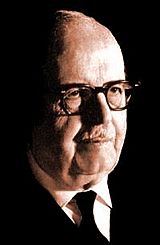Bernardo Houssay facts for kids
Bernardo Alberto Houssay (born April 10, 1887 – died September 21, 1971) was an Argentine scientist who studied the human body. He won the 1947 Nobel Prize for Physiology or Medicine. He shared this prize with Carl Ferdinand Cori and Gerty Cori. Houssay won because he found out how hormones from the pituitary gland help control the amount of glucose (sugar) in animals. He was the first person from Latin America to win a Nobel Prize in science.
Quick facts for kids
Bernardo Houssay
|
|
|---|---|

Bernardo Houssay
|
|
| Born |
Bernardo Alberto Houssay
April 10, 1887 |
| Died | September 21, 1971 (aged 84) |
| Nationality | Argentine |
| Known for | Glucose |
| Awards | Nobel Prize for Physiology or Medicine (1947) James Cook Medal (1948) |
| Scientific career | |
| Fields | Physiology, endocrinology |
Contents
About Bernardo Houssay
Early Life and Studies
Bernardo Alberto Houssay was born on April 10, 1887, in Buenos Aires, Argentina. His parents, Albert and Clara Houssay, had moved there from France. Bernardo was very smart from a young age.
He started studying at the Pharmacy School at the University of Buenos Aires when he was just 14 years old. Later, at 17, he joined the Medical Faculty at the same university. While he was still a medical student, he began working as a research and teaching assistant in the Physiology department.
Starting His Career
After finishing medical school, Houssay quickly wrote his M.D. thesis. It was about how extracts from the pituitary gland affect the body. This topic became very important for his future research.
In 1908, he was an assistant lecturer. After getting his doctorate, he became a Professor of Physiology at the University's School of Veterinary Medicine. At the same time, he also worked as a doctor at a hospital in Buenos Aires. By 1915, he was the Chief of Experimental Pathology at the National Public Health Laboratories.
Leading Research
In 1919, Houssay became the head of physiology at the University of Buenos Aires Medicine School. He made this department a world-famous center for research in experimental physiology and medicine.
During his career, he faced challenges. Due to his political views, he was twice removed from his university jobs. However, he did not give up his research. He continued his work and led his team at a privately funded institute called the Instituto de Biología y Medicina Experimental. He was later able to return to the University of Buenos Aires. From 1957 onwards, he also directed the National Scientific and Technical Research Council.
His Big Discovery
Houssay studied many areas of physiology. But his most important work was about how the front part of the pituitary gland affects how the body uses carbohydrates, especially in people with diabetes.
In the 1930s, Houssay showed that extracts from the front part of the pituitary gland could cause diabetes. He also found that if this part of the gland was removed, diabetes became less severe. These discoveries were very important. They helped scientists understand how hormones control many body functions. This groundbreaking work led to him receiving the Nobel Prize in Physiology or Medicine in 1947.
Teaching and Legacy
Many of Houssay's students became important scientists themselves. They spread his knowledge around the world. For example, Miguel Rolando Covian became known as the "father" of Brazilian neurophysiology.
Houssay and his students wrote a very important textbook on Human Physiology. It was published in Spanish and Portuguese. Since 1950, this book has been used in almost all medical schools in Latin America. Houssay published more than 600 scientific papers and several specialized books.
Besides the Nobel Prize, Houssay received many honors. He got awards from famous universities like Harvard, Cambridge, Oxford, and Paris. He also won the Dale Medal in 1960.
Houssay was also a strong leader. He worked hard to promote scientific research and medical education in Argentina and across Latin America. In 1943, he was made a Foreign Member of the Royal Society.
Remembering Houssay
- In 1996, a research ship was named the Dr. Bernardo Houssay (MOV1) in his honor.
See also
 In Spanish: Bernardo Houssay para niños
In Spanish: Bernardo Houssay para niños

